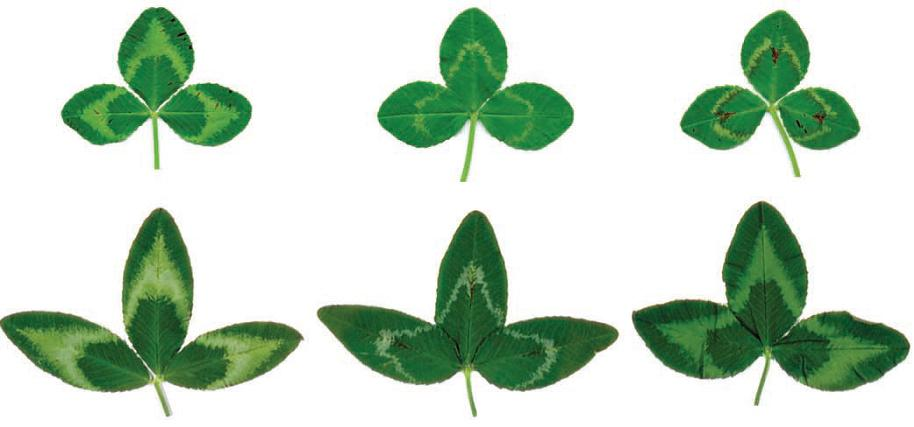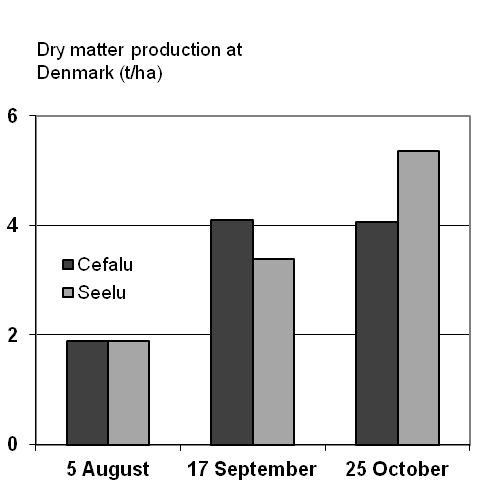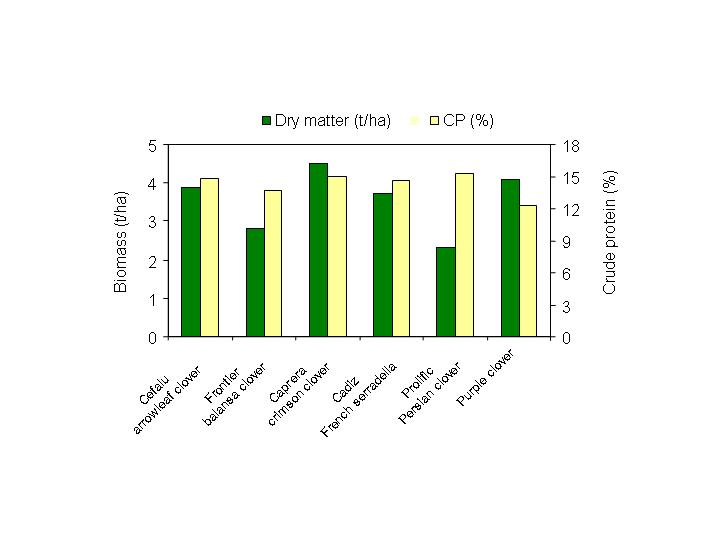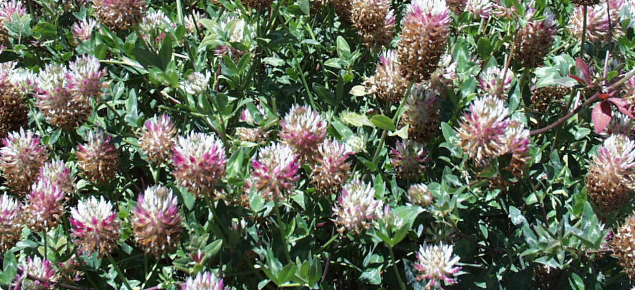Species description
Young plants of arrowleaf clover are similar in appearance to many other clovers. But leaves of mature plants are distinctively diamond or arrowhead shaped. Leaves have distinctive white or green V-shaped marks and sometimes indistinct red marks.
Mature plants can reach a height of over 1m when growing in swards. Flowering heads are large (up to 6cm long and 2cm in diameter) and consist of many individual flowers. Petals change in colour from white to pink and later to bronze. The bronze petals persist in the fruiting heads which elongate to 10cm. The calyx becomes inflated when in fruit which is also typical of Persian and bladder clovers. Seed heads remain intact on the stem, however, seed often sheds soon after maturity. Seeds are brown, yellow or green in colour, and weigh about 1.2mg (slightly larger than Balansa and Persian clovers but much smaller than subterranean clover).

Origin and description of Cefalu
Arrowleaf clover occurs naturally in Italy, Greece, Corsica, western Turkey, the Balkans and north of the Black Sea. Cefalu was selected by Richard Snowball, Curator of the Australian Trifolium Genetic Resource Centre. It originated from an early flowering plant within a population of the cultivar Seelu. This early flowering plant underwent further selections for early flowering and prostrate growth habit. While individual plants are relatively prostrate, they are strongly upright in dense swards.
Cefalu was released in Australia in 1999 by the Centre for Legumes in Mediterranean Agriculture (CLIMA), University of Western Australia. Cefalu appears similar to other arrowleaf clover cultivars. The white V-shaped leaf marks are more common (85% of plants) than with Seelu (68%), Zulu II (68%) and Arrotas (30%). The most marked difference is the time to first flowering. Cefalu commences flowering about 135 days from sowing in Perth, about two weeks earlier than Seelu or Zulu II and six weeks earlier than Arrotas.
Adaptation
Cefalu grows best on fertile soils with pH 4.5–7.5 (measured in CaCl2). It is deep-rooted and prefers deep, well drained sandy and loamy soils. It also performs well in the presence of perched fresh water tables, providing extended periods of green feed for grazing animals.
The earlier maturity makes it suitable for areas receiving as little as 400mm annual rainfall, extending arrowleaf clover into the medium rainfall wheatbelt. In these shorter season areas, Cefalu performs significantly better than Seelu. This is particularly true on sandy soils where moisture is more limited and deeper in the profile, and also on well-structured finer textured soils where stored soil moisture can be utilised.


When tested on a relatively fertile gravelly soil at Gillingarra (100km north of Perth) Cefalu performed well compared with a number of other pasture legume species, producing a large amount of biomass with good feed quality. At several high rainfall sites in the south west of the state early season growth of Cefalu was better than Seelu. However, favourable late spring conditions resulted in better growth of later maturing varieties.
Cefalu has limited tolerance to waterlogging, particularly at the seedling stage, when plant death may occur. However, there can be exceptional production on the edge of wet country when Cefalu can tap into perched fresh water tables. This can extend the growing period for up to two months.

Uses
Cefalu is a prolific seed producer but has only a moderate level of hard seed compared with species such as yellow serradella and biserrula. It can be used in a short phase pasture of two or three years and will regenerate after one year of a cereal crop. However, it is unlikely to persist in a 1:1 rotation.
Seed production and persistence are enhanced by rotational grazing, particularly during flowering. Its greatest value is for conserved fodder production. The sturdy, upright growth habit makes it suitable for conventional mowing and hay baling machinery.
Nutritive value of hay made with Cefalu is high. It can also be mixed with a cereal, such as oats, to boost production. The seeding rate of the cereal needs to be kept relatively low because cereals with high tillering ability and fast growth under low temperatures will out-compete Cefalu in the stand early in the season and reduce its spring production. A successful hay mixture is likely to result when the cereal is sown at 10–20kg/ha with Cefalu at 10–12kg/ha. Regenerating Cefalu pastures also have potential to be cut for hay or silage.
Establishment
Unlike very soft-seeded pasture legume species such as Crimson clover and Cadiz French serradella, seed of Cefalu should be scarified prior to sowing. Germination testing is also recommended.
The sowing rate should be 2–4kg/ha for general pasture establishment, 5–10kg/ha for seed crops and 10–20kg/ha for hay or silage crops. Due to its small seed size, care must be taken to sow shallow (0.5–1cm).
Seed should be inoculated and lime-pelleted using group C inoculant. Cefalu responds well to improved soil fertility. Phosphorus and potassium levels need to be maintained, particularly if the pasture is used for seed or fodder crops.
Cefalu is susceptible to redlegged earth mite at the seedling stage and can be controlled by practicing TIMERITE® in preceding years, and by applying post-emergent insecticides if numbers of mites are at damaging levels. Once plants are well established there are few insect problems, although large populations of aphids can reduce seed production.
Several viruses affect arrowleaf clover, the most serious being Bean Yellow Mosaic Virus (BYMV). Control is best achieved by sowing virus free seed and controlling aphids. It is also possible to reduce the production of virus-infected seed by allowing healthy plants to out-compete infected plants. This is best achieved by reducing stocking rates.
Weed control
Broadleaf weeds can be a problem, especially at the early stages of establishment and in regenerating pastures. Trial results indicate that Cefalu is sensitive to paraquat, simazine, diuron and bromoxynil-based herbicides. Very few available herbicides are registered for use on arrowleaf clover pastures.
Ensure there is adequate opportunity for control of weeds with knockdown herbicides in the establishment year. Most annual grasses can be controlled with selective grass herbicides. Once a good stand is established, Cefalu can become very competitive and the dense canopy can help reduce weed growth.
Grazing
Animals grazing Cefalu will not have bloating problems. However, grazing pressure should be light during establishment, due to its relatively slow early growth and upright habit.
Although spring growth is more vigorous, grazing pressure at flowering time should be reduced. This will ensure enough seed heads escape grazing, further ensuring adequate seed production for regeneration in the following season or after a crop.
Grazing in summer to remove most of the dry matter is very important to ensure good autumn regeneration. Due to the relatively small seed and its dislodgement from mature plants, adequate seed will usually escape grazing to ensure regeneration. Approximately 30 per cent of the seeds that are ingested might be expected to pass through the animal’s digestive system unaffected.
Its erect growth habit also makes Cefalu ideal for grazing with cattle. It does not contain oestrogenic compounds and will not cause ewe infertility or difficult lambing associated with some older subterranean clover varieties.
Seed production
The tall, upright habit and high tolerance to lodging makes it easy for seed harvesting with conventional, open front cereal harvesters. Seed is easily threshed from the heads, although wind speed may need to be reduced. The threshing process usually results in a very clean header sample. Do not delay harvesting, as seed can be shed from the seed heads unnoticed.
Production and marketing
Cefalu is protected under the Plant Breeders Rights Act 1994. Under the Act there is no restriction on producing seed for one’s own use (farmer’s privilege) or from sale of produce, such as hay or silage. However, sale of Cefalu seed can only be carried out by agreement with the licensees (West Coast Seeds and Heritage Seeds).
Sale includes exchange by way of a barter arrangement. Unauthorised propagation of seed for commercial purposes or sale is an infringement under section 53 of the Plant Breeders Rights Act 1994 and is subject to prosecution.
Acknowledgements
The information provided on this page was generated through research partly funded by the Australian Wool Innovation Ltd, the Grains Research and Development Corporation and the Rural Industries Research and Development Corporation.

